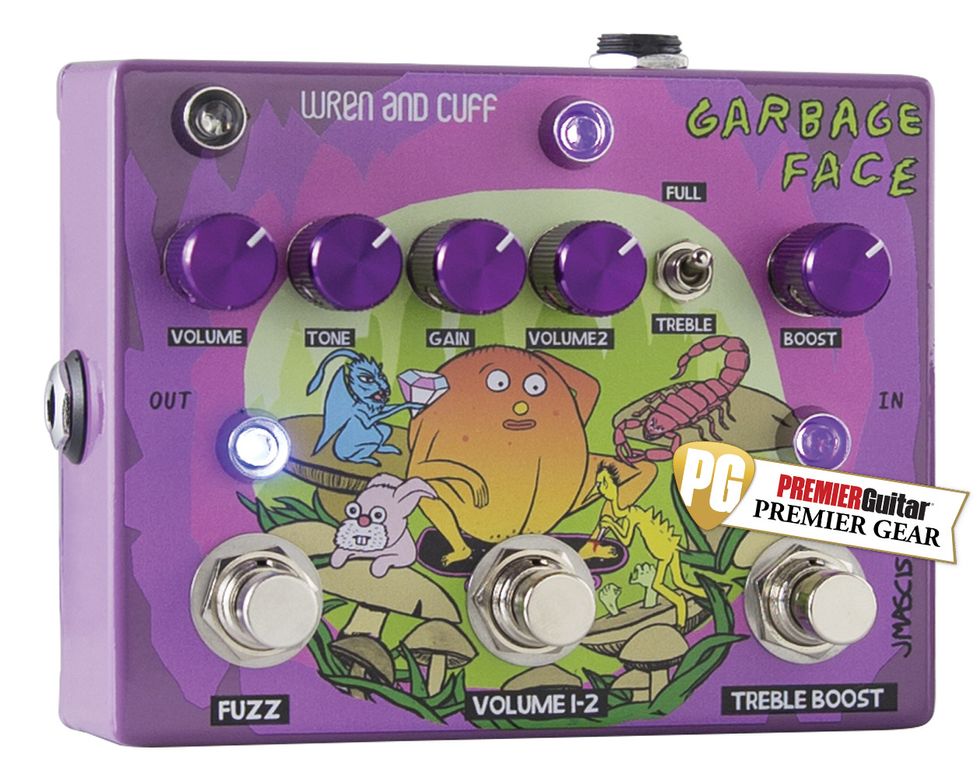
RatingsPros:Rich, complex, and searing Ram’s Head-style tones. Simple but brilliant dual master output section. Effective and versatile treble booster. Cons: Cramped footswitch array. Street: $349 Wren And Cuff Garbage Face wrenandcuff.com | Tones: Ease of Use: Build/Design: Value: |
Though it isn’t always easy to tell over the sheer volume, J Mascis’ live sound is a complex tapestry. Waves of modulation weave in and out of phrases. Wah blasts hit like shots of nitrous oxide. Delay repeats flash like meteorite tails. But the beating heart of this deafeningly exploding nebula is a 40-something-year-old “Ram’s Head” EHX Big Muff that has soldiered on through more than a few scrapes. In 2017, it was crushed by a falling amplifier cabinet and resuscitated by Big Muff specialist and Wren And Cuff founder Matt Holl. That repair led to this pedal.
The Garbage Face, which was built with significant input from Mascis, is a first-rate Ram’s Head Big Muff clone that captures the rage and expansiveness of J’s original. But it also extends the Muff circuit’s versatility by adding a footswitchable second master volume switch and a treble booster—effectively replicating one of the most vital sections of Mascis’ live rig in a single pedal.
Freak Scene
Mascis’ writing and arranging style could, in many cases, be classified as many shades of loud. And if you’ve spent any time investigating this performance method (and when you realize how spacious and dynamic Mascis’ songs are relative to other loud-on-loud styles like metal and hardcore), you know that walking the fine line between a big, fuzzy rhythm sound that leaves room for vocals and a more scorching setting for leads can be tricky. Mascis has used several solutions to achieve this rhythm/lead contrast over the years, including stacked Big Muffs, overdrives in front of Muffs, and treble boosters upstream from his Ram’s Head.
The latter approach is replicated in the Garbage Face, which situates a germanium Rangemaster-based booster before the Muff circuit. The treble boost section also features a treble/wide switch that moves between a very hot, toppy boost and a more contoured, low-end-heavy setting. The Garbage Face provides another, more inventive, way of achieving the fuzzy loud-to-louder dynamic in the form of a second master volume/output control that can be set dramatically quieter or louder than its opposite.
The entire scheme is controlled via five knobs, a treble booster voicing switch, and an array of three footswitches that activate the fuzz and the treble booster, and enable switching between the two output volumes. The pedal is built to Wren And Cuff’s usual super-high standards and the control set is easy to master. If there is a design drawback, it’s that the footswitches can feel crowded on such a compact enclosure.
Correct For Drift
Matt Holl’s time under the hood of Mascis’ favorite Muff yielded some surprises. Many component values were off from their declared values by as much as 40 percent. That’s not that unusual for a vintage pedal—of any type. What was difficult was replicating the performance of so many drifting-value parts with modern equivalents. The answer, according to Holl, meant occasionally stacking components to achieve a best approximate value. The audible results of Holl’s exactitude are impressive.
Take a Run at the Sun
Most builders accept that building a definitive version of any vintage fuzz verges on folly. (A fact underscored by the value drift Holl encountered in measuring the original components.) But Holl’s aspirations to achieve authenticity in the Garbage Face pay big dividends and reveal much about why good EHX Ram’s Heads are so coveted in the first place. For starters, there’s a perceptible sense of space, air, and headroom in the Garbage Face’s output. Sure, high-gain settings will compress the hell out of your signal, but if you compare the compression and space you hear from the Garbage Face to the highest gain settings of, say, a Sovtek Muff-style fuzz, there’s no contest. The Garbage Face gives individual notes more room to bloom, making solos more lyrical and chords much more articulate. It’s little wonder that Mascis leaned so heavily on the Ram’s Head to lend mass to the folk-rock underpinnings behind many Dinosaur Jr. tunes.
Note articulation is also improved by a very effective tone knob, which can add a lot of detail (and a lot of sizzle at high gain and volume settings) and dishes the darkness for more sludge-oriented Muff pilots. Similar brightening and detail-enhancing effects can be achieved with the treble booster. It’s not an easy effect to add at high volume and high gain—things got very squirrelly when I had a go at replicating the Dinosaur Jr. experience by using the treble booster and Muff circuit together in front of a 100-watt Marshall and a 4x12. But it’s important to remember that the Garbage Face can do much more than just reproduce Dinosaur’s live megatonnage. In fact, the available range in the tone controls and the treble booster (as well as the ability to use the latter independently) means you can conjure mid-’60s freakbeat fuzz sounds, sustaining cello lead tones, raspy garage textures, and chugging mid-gain rhythm colors. Add the ability to switch between two different output levels and the Garbage Face’s tone library adds up to an expansive collection.
The Verdict
It’s hard to imagine a Big Muff enthusiast not being intrigued by the potential of the Wren And Cuff Garbage Face. Like most really good Ram’s Head-based circuits, it covers 90 to 95 percent of the Big Muff tones most players want—save for a few very wooly or icy textures that are unique to Sovtek- and “triangle”-style circuits. But the utility that comes with the addition of the germanium treble booster, a wide-range tone control, and the unique switchable output section goes a long way toward making the Garbage Face a complete multi-gain solution.















![Rig Rundown: Russian Circles’ Mike Sullivan [2025]](https://www.premierguitar.com/media-library/youtube.jpg?id=62303631&width=1245&height=700&quality=70&coordinates=0%2C0%2C0%2C0)









